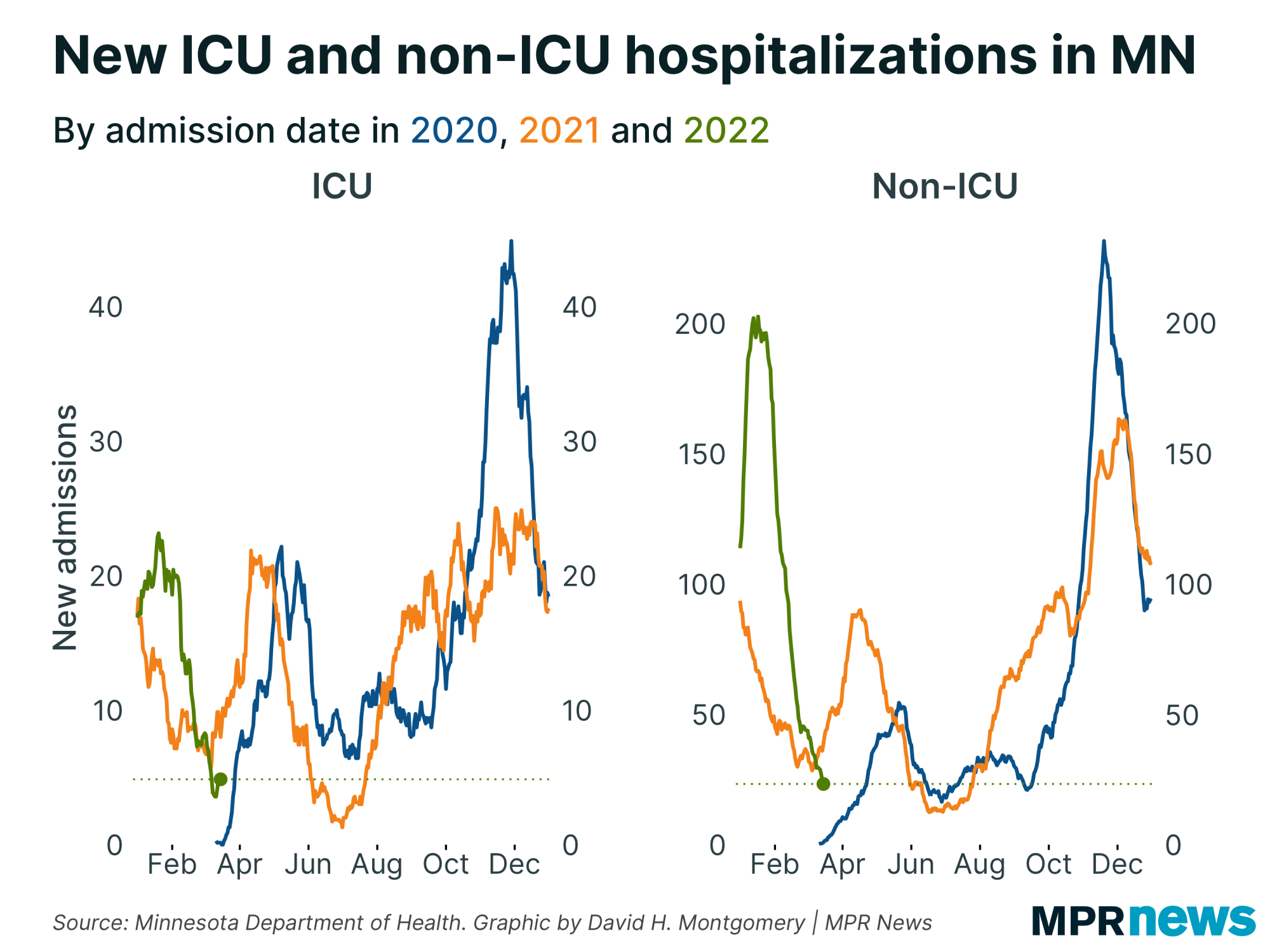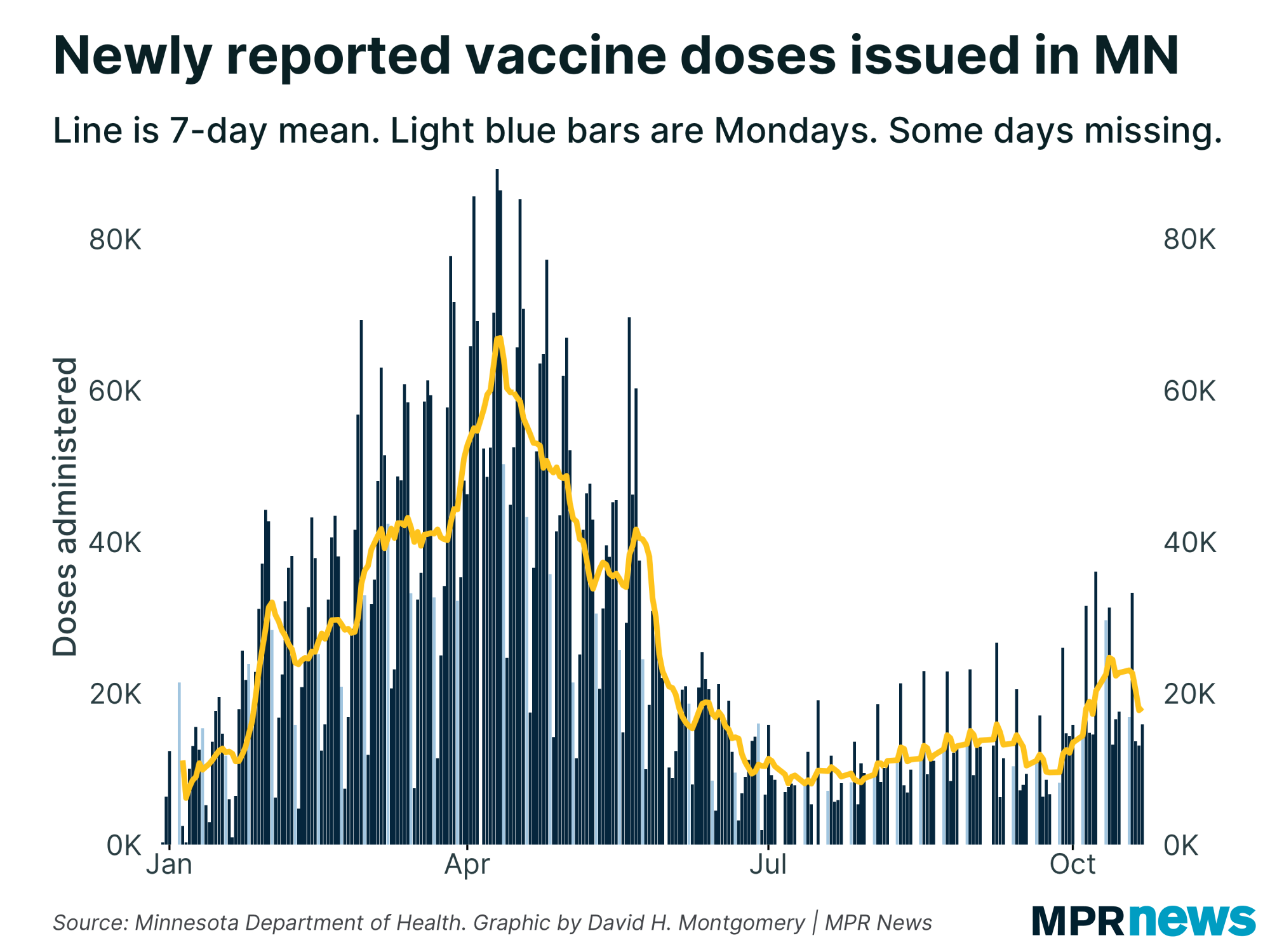Jan. 28 update on COVID-19 in MN: Positive trends steady; vaccinations accelerate

Go Deeper.
Create an account or log in to save stories.
Like this?
Thanks for liking this story! We have added it to a list of your favorite stories.
Updated: 3:20 p.m.
Minnesota’s newest COVID-19 numbers show trends remaining positive heading toward February.
New and active caseloads ticked up a little from the prior day’s report, but the trend lines on hospitalizations, active cases and vaccinations continue to be encouraging.
The Health Department on Thursday reported another 1,335 confirmed or probable COVID-19 cases — along with 16 more deaths.
Active, known COVID-19 case counts came in at 9,893, up a bit from the prior day, although the trend still looks good. That count has stayed below 10,000 three straight days for the first time since mid-October. Active caseloads hovered around 50,000 in late November.
Turn Up Your Support
MPR News helps you turn down the noise and build shared understanding. Turn up your support for this public resource and keep trusted journalism accessible to all.

The state’s now recorded 458,633 cases in the pandemic. Of those, about 97 percent of people have recovered to the point they no longer need to be isolated.

The newly reported deaths raised Minnesota’s toll to 6,140. Among those who’ve died, about 63 percent had been living in long-term care or assisted living facilities; most had underlying health problems.

The number of Minnesotans hospitalized with COVID-19 stood at 477 as of Tuesday, with 97 needing intensive care.

The generally positive outlook is being tempered now by concerns of new virus strains arriving in the United States. All three known new COVID-19 variants have now been confirmed in the U.S., including a case of the Brazilian strain identified this week in Minnesota.
That has Michael Osterholm, head of the University of Minnesota's Center for Infectious Disease Research and Policy, worried about a looming spike in cases.
These more infectious variants “are now going to overlay on top of that very high baseline so what we can expect to see in the course of the next I think six to 14 weeks is something that we haven't even come close to experiencing yet,” Osterholm told CNN.
Cases spread across age groups, regions
People in their 20s still make up the age bracket with the state’s largest number of confirmed cases — more than 87,000 since the pandemic began, including more than 46,000 among people ages 20 to 24.

The number of high school-age youth confirmed with the disease has also grown, with more than 35,000 total cases among those ages 15 to 19 since the pandemic began.
Although less likely to feel the worst effects of the disease and end up hospitalized, experts worry youth and young adults will spread it to older relatives and members of other vulnerable populations.
It’s of particular concern because people can have the coronavirus and spread COVID-19 when they don’t have symptoms.
Caseloads are trending down across all regions of the state following a late December, early January blip.

Hot spots continue to pop up in rural counties relative to their population.

Caseloads still heaviest among people of color
In Minnesota and across the country, COVID-19 has hit communities of color disproportionately hard in both cases and deaths. That’s been especially true for Minnesotans of Hispanic descent for much of the pandemic.

Even as new case counts ease from their late November, early December peaks, the data shows people of color continue to be hit hardest.
Distrust of the government, together with deeply rooted health and economic disparities, have hampered efforts to boost testing among communities of color, officials say, especially among unauthorized immigrants who fear their personal information may be used to deport them.
Similar trends have been seen among Minnesota’s Indigenous residents. Counts among Indigenous people jumped in October relative to population.
Vaccinated by opening day of baseball season?
State leaders were challenged early on to get COVID-19 vaccine shots into arms quickly, and took criticism that the process has been too slow. But the latest numbers show the upswing in vaccinations may finally be underway.

More than 320,000 Minnesotans received at least one dose of COVID-19 vaccine as of Tuesday, about 5.8 percent of the state’s population.
The seven-day rolling average for new vaccinations topped 20,000, the highest point since vaccinations started in late December, and more than double where that figure stood a week ago.
The climb in vaccinations is encouraging news in what’s been a hopeful two weeks in the pandemic. Still, vaccine demand continues to far outpace supply.
Touring a vaccination effort Thursday in Brooklyn Center, Gov. Tim Walz expressed hope that as the state got more vaccine, local clinics and pharmacies would be the main spots for people to get vaccinations.
Walz said the state is line to get a 16 percent increase in vaccine shipments from the federal government, allowing Minnesota officials to plan three weeks ahead rather than days ahead.
With COVID-19 conditions improving now and vaccinations picking up, "we're starting to win that fight a little bit," Walz told reporters.
The governor said he's hoping that for Minnesotans "in my situation," a middle-aged person in reasonably good health, "most of us should hopefully be getting that (vaccine) by March and April. I've told my team I want it by opening day of baseball season."
Opening day for the Minnesota Twins is April 1. The home opener is set for April 8.
Developments from around the state
Some Twin Cities teachers put on vaccine waitlist after invites forwarded
Thousands of Minnesota teachers were put on a vaccine waitlist after state officials made changes to a pilot program for educators this week.
State officials allotted close to 15,000 vaccines for metro-area educators this week, but then instructed school officials to invite more than 26,000 people in this group to get vaccinated. In some cases, school staff forwarded invitations to others not on priority lists.
St. Paul teacher union president Nick Faber said many teachers who received invitations were not able to get appointments.
“It should be good news about these vaccines and it’s turning into the ‘Hunger Games,’” Faber said.
Education Department spokesperson Ashleigh Norris said officials intentionally shared invitations with more people in an effort to make sure no vaccine doses went unused this week. Norris said officials are reviewing registrations to make sure everyone who registered is a school staff member.
“This week, knowing that we had a lot more, we didn’t actually allocate anything to any district, we gave each district a recommended number of staff that they should share the registration link with, which was more than the number of slots that were available, knowing that not everyone was going to want it,” Norris said.
Norris said officials expect more doses from the federal government that would help with problems in the future while they continue to review and adjust the pilot program.
— Elizabeth Shockman | MPR News
Mia, Walker Art Center reopening after weekslong closure
The Minneapolis Institute of Art reopens Thursday after a two-month hiatus.
The museum closed to the public Nov. 21 amid a surge in COVID-19 cases in Minnesota.
Reservations are required, and the building is limited to 150 visitors at a time. Walkup tickets are not available.
The Walker Art Center is also scheduled to reopen next Thursday, Feb. 4, with similar safety protocols.
— Matt Sepic | MPR News
Top headlines
Minnesota restaurants welcome return of diners: Restaurant owners say Minnesotans are taking advantage of the return to in-person dining. The state's hospitality businesses got the go-ahead to reopen to limited inside drinking and dining earlier this month. Though they might prefer opening at full capacity, they’re focused on avoiding a return to harsher restrictions.
House DFL bill would offer safety protections for meatpacking workers: A state lawmaker is pushing for stronger safety protections for workers at Minnesota meat and poultry processing plants, where COVID-19 outbreaks sickened hundreds of employees during the pandemic.
Expired driver's licenses, IDs should be renewed soon, Minnesota officials say: A COVID-19-related extension for Minnesota driver's license renewals is ending soon. Minnesota law does not allow for additional extensions, so people whose licenses would have expired between March 13 of last year and the end of this February should plan to renew soon, according to the Department of Public Safety.
COVID-19 in Minnesota
Data in these graphs are based on the Minnesota Department of Health's cumulative totals released at 11 a.m. daily. You can find more detailed statistics on COVID-19 at the Health Department website.
Dear reader,
Political debates with family or friends can get heated. But what if there was a way to handle them better?
You can learn how to have civil political conversations with our new e-book!
Download our free e-book, Talking Sense: Have Hard Political Conversations, Better, and learn how to talk without the tension.




